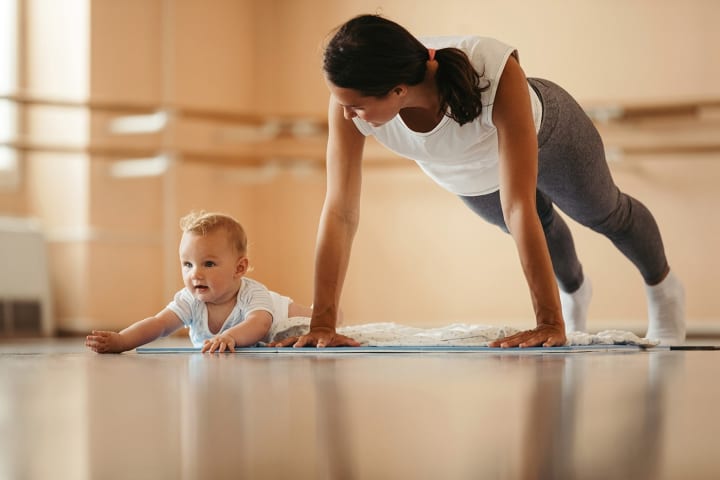Empowering Families through Fitness: A Comprehensive Guide to Exercising with Kids
Nurturing Healthy Families through Fitness: A Guide to Exercise for Parents and Kids

In today's fast-paced world, maintaining a healthy lifestyle can be a challenge, especially for parents juggling work, family responsibilities, and personal well-being. Regular exercise is crucial for both physical and mental health, but it can often fall by the wayside when caring for young children. However, incorporating your little ones into your workout routine can be a rewarding experience that benefits everyone involved.
The Benefits of Exercising with Your Kids
- Promotes Family Bonding: Spending quality time together while engaging in physical activity strengthens family bonds and creates lasting memories.
- Instills Healthy Habits: Exposing children to regular exercise from an early age sets a positive example and encourages them to develop healthy habits that can last a lifetime.
- Improves Overall Health: Exercise boosts physical fitness, reduces the risk of chronic diseases, and enhances mental well-being for both parents and children.
- Creates Positive Associations: Associating exercise with fun and family time makes it more enjoyable and encourages continued participation.
Strategies for Exercising with Young Children
- Embrace Bodyweight Workouts: Bodyweight exercises like squats, lunges, planks, and jumping jacks are simple, effective, and require no equipment, making them ideal for home workouts with kids.
- Incorporate Playful Elements: Turn exercise into a fun game by incorporating games, challenges, and music to keep kids engaged and motivated.
- Utilize Household Objects: Everyday household items like chairs, steps, and toys can be transformed into props for creative exercises and obstacle courses.
- Make it a Family Affair: Encourage siblings to participate together, fostering a sense of camaraderie and teamwork.
Age-Appropriate Exercises for Kids
- Preschoolers (3-5 Years Old): Focus on basic movements like walking, running, jumping, and animal walks.
- Kindergarteners (5-7 Years Old): Introduce simple bodyweight exercises, jumping rope, and obstacle courses.
Elementary Schoolers (7-12 Years Old): Gradually increase the intensity and duration of workouts, incorporating more complex exercises.

Safety Guidelines for Exercising with Kids
- Choose a Safe Environment: Exercise in an open, safe area free from hazards like traffic, sharp objects, or uneven surfaces.
- Supervise Closely: Pay constant attention to your child's safety, ensuring proper form and preventing injuries.
- Listen to Your Child's Needs: Be mindful of their energy levels and adjust the intensity accordingly.
- Take Breaks as Needed: Allow regular breaks for hydration and rest.
- Make it Enjoyable: Focus on creating a positive and fun atmosphere that encourages continued participation.
Tips for Overcoming Challenges
- Be Flexible and Adaptable: Expect some disruptions and be prepared to adjust your workout plan on the fly.
- Embrace the Chaos: Don't strive for perfection; focus on enjoying the time together and fostering a love of physical activity.
- Incorporate Technology: Utilize fitness apps, online videos, or interactive games to keep kids engaged.
- Seek Support: Enlist the help of a family member or friend to provide childcare during workout sessions.
Sample Workout Routines for Different Age Groups
Preschoolers (3-5 Years Old)
- Animal Walk: Pretend to be different animals, imitating their movements (e.g., crab walk, bear crawl, frog hop).
- Dancing Extravaganza: Put on some upbeat music and dance around the house, encouraging silly moves and animal impressions.
- Obstacle Course Adventure: Create an obstacle course using household items like pillows, blankets, chairs, and toys.
- Simon Says: Play Simon Says, incorporating physical movements like jumping jacks, high knees, and arm circles.
Kindergarteners (5-7 Years Old)
- Bodyweight Boot Camp: Perform simple bodyweight exercises like squats, lunges, planks, and jumping jacks, making them fun with animal names (e.g., kangaroo squats, penguin lunges, elephant planks, froggy jumping jacks).
- Treasure Hunt Workout: Create a treasure hunt with clues that involve different exercises (e.g., do 10 jumping jacks before the next clue).
- Balance Beam Challenge: Use a balance beam or a raised edge to practice balancing while walking, hopping, or doing animal walks.
- Yoga for Kids: Find a kid-friendly yoga video or app and follow along with poses like downward-facing dog,cat-cow pose, and tree pose. Choose a yoga instructor who is experienced in teaching children and avoid poses that are too difficult or could strain the body.
Elementary Schoolers (7-12 Years Old)
- Cardio Kickboxing: Put on some energetic music and practice basic kickboxing moves like punches, kicks, and blocks. Ensure proper form and technique to avoid injury, and encourage children to modify movements if needed.
- Partner Workout Games: Play games that involve partner exercises, such as back-to-back squats, piggyback rides, and wheelbarrow races. Supervise closely to ensure safety and avoid games that could cause collisions or injuries.
- Circuit Training: Create a circuit of different exercises, such as push-ups, sit-ups, jumping jacks, and burpees. Take short breaks between stations and gradually increase the number of repetitions as children's fitness improves.
- Nature Walk with Exercise Breaks: Take a walk in a park or nature trail, incorporating exercise breaks along the way. Perform bodyweight exercises, practice balancing on logs or rocks, or do jumping jacks while counting trees.
Safety Guidelines for Exercising with Kids
- Choose a Safe Environment: Exercise in an open, safe area free from hazards like traffic, sharp objects, or uneven surfaces. Always be aware of your surroundings and potential dangers.
- Supervise Closely: Pay constant attention to your child's safety, ensuring proper form and preventing injuries. Be prepared to intervene if any unsafe
About the Creator
Ivan Islam
I am just a random freelancer writing about the things I research, observe myself and verify by experts. Want to let the world know about my works nd features. Please support, subscribe and read thoroghly. Thank U All.
Enjoyed the story? Support the Creator.
Subscribe for free to receive all their stories in your feed. You could also pledge your support or give them a one-off tip, letting them know you appreciate their work.





Comments
There are no comments for this story
Be the first to respond and start the conversation.